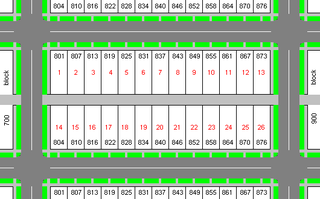
A city block, residential block, urban block, or simply block is a central element of urban planning and urban design.
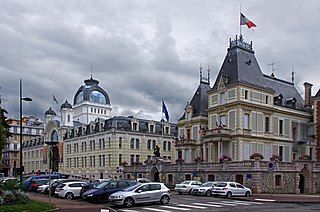
An administrative centre is a seat of regional administration or local government, or a county town, or the place where the central administration of a commune is located.

Christian de Portzamparc is a French architect and urbanist.

The Ministry of Ecological Transition, commonly just referred to as Ministry of Ecology, is a department of the Government of France. It is responsible for preparing and implementing the government's policy in the fields of sustainable development, climate, energy transition and biodiversity. Christophe Béchu was appointed Minister of Ecological Transition on 11 January 2024 under Prime Minister Gabriel Attal.
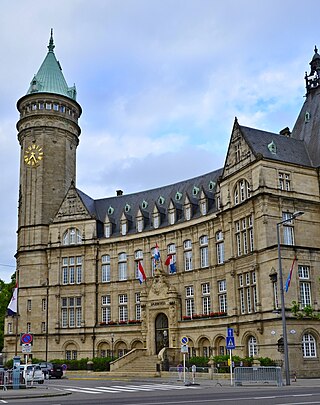
The State Bank and Savings Bank, also known by its Luxembourgish name Spuerkeess, is the leading national financial institution founded in 1856 and governed by the law of 24 March 1989. Spuerkeess is a commercial bank wholly owned by the government of Luxembourg.

The National Library of Luxembourg, abbreviated as BnL, is Luxembourg's national library. It was founded in its current form in 1899, as a result of a series of different institutions originating in the 18th century. It is located in the Kirchberg district of Luxembourg City. The BnL is a public establishment under the supervision of the Ministry of Culture.

The first Juncker–Asselborn Government was the government of Luxembourg between 31 July 2004 and 23 July 2009. It was led by, and named after, Prime Minister Jean-Claude Juncker and Deputy Prime Minister Jean Asselborn.

The Juncker–Polfer Government was the government of Luxembourg between 7 August 1999 and 31 July 2004. It was led by, and named after, Prime Minister Jean-Claude Juncker and Deputy Prime Minister Lydie Polfer.
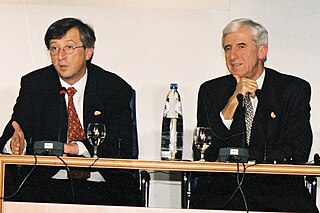
The Juncker–Poos Government was the government of Luxembourg between 26 January 1995 and 7 August 1999. It was led by, and named after, Prime Minister Jean-Claude Juncker and Deputy Prime Minister Jacques Poos.

The Santer-Poos I Government was the government of Luxembourg between 20 July 1984 and 14 July 1989. It was the first of three led by Prime Minister Jacques Santer, and the first to have Jacques Poos as Deputy Prime Minister.

Drinking water supply and sanitation in Benin has been subject to considerable progress since the 1990s, in particular in rural areas, where coverage is higher than in many other African countries, and almost all development partners follow a national demand-responsive strategy, which has been adopted in 1992. New strategies to increase water supply in rural and urban areas have been adopted in 2005 and 2006. Tariffs in urban and rural areas are usually high enough to cover the costs for operation and maintenance.
The 2009 Luxembourgish plan for the housing sector is a program developed by the government of Luxembourg with the help of several other bodies in order to improve the housing problem in Luxembourg. It has been created in accordance with the IVL document. It aims at achieving lower land prices and higher urban densities while maintaining the same quality of life.

The Luxembourg Institute of Socio-Economic Research (LISER) is a research centre located in Esch-sur-Alzette, Luxembourg.

The history of rail transport in Luxembourg began in 1846 and continues to the present day.
The Ministry of Sustainable Development and Infrastructure is a ministry of the Government of Luxembourg. Its head office is in the City of Luxembourg. As of 4 December 2013, François Bausch is the minister.
The German Association for Housing, Urban and Spatial Development is a politically independent association and registered with an approved non-profit status. It is concerned with key questions and future perspectives of the housing and real estate industry, urban planning and spatial development.
The Association of Luxemburg Student Unions, abr. ACEL, founded in 1984 is the roofing bond of Luxembourgish student unions and represents more than 40 student unions, all spread across Europe. Therefore, ACEL is representing more than 10000 Luxembourgish students. It is hence considered as the most important student representative in Luxemburg. ACEL is politically non-committed, it represents no party opinion. Claiming to be the representative of all Luxembourgish students, this is particularly important to function properly.
A biodiversity reserve of Quebec is a protected area established to promote maintenance of biodiversity in the terrestrial environment and more specifically to maintain representatives of the various natural regions of Quebec, Canada. There are five biodiversity reserves in Quebec with permanent protection status.
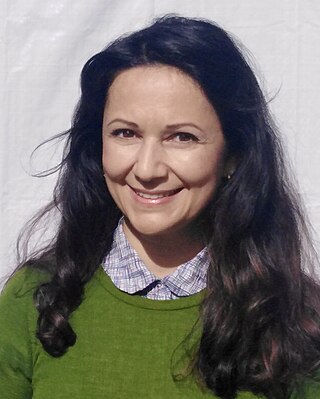
Semiray Ahmedova is a Luxembourgian architect and politician of The Greens. She became a deputy in 2019.

The 15-minute city is an urban planning concept in which most daily necessities and services, such as work, shopping, education, healthcare, and leisure can be easily reached by a 15-minute walk, bike ride, or public transit ride from any point in the city. This approach aims to reduce car dependency, promote healthy and sustainable living, and improve wellbeing and quality of life for city dwellers.














